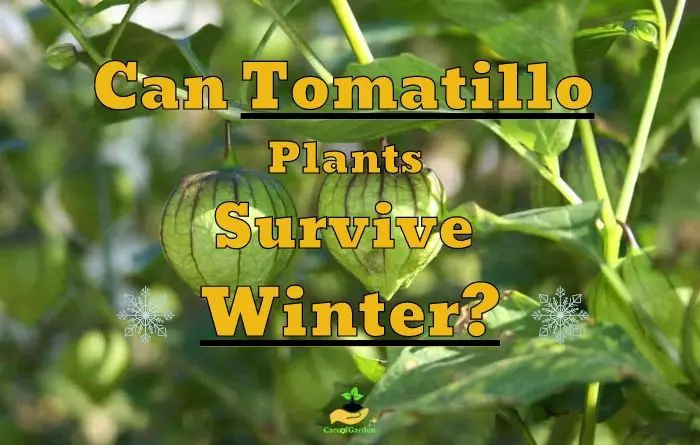Can Tomatillo Plants Survive Winter? (Here Is The Answer)
When I teach new gardeners how to care for unconventional plants, many people ask me if tomatillo plants can survive the winter.
The short answer is yes, but whether tomatillo plants survive winter depends on several factors. In this article, I will talk about some that I learned in these years growing tomatillo and how to deal with the winter problem.
Can tomatillo plants survive winter?
Yes, tomatillo plants can survive mild winter in some regions, but it depends on the variety and the severity of the weather. While tomatillos are typically grown as annual plants, some varieties are more frost-tolerant and may survive light frosts or mild winters. Tomatillo plants will not survive hard freezes or prolonged periods of cold weather, but you can try covering them with frost blankets or moving them indoors to a sunny window to protect them from extreme cold temperatures. Keep in mind that tomatillos are not well-suited to indoor growing and may not produce as well as they would in an outdoor garden.
Table with Tomatillos varieties that are known to tolerate frost
| Tomatillo Variety | Frost Tolerance | Cold Temperature Tolerance |
|---|---|---|
| De Milpa | Mild to Moderate | 50°F to 60°F |
| Toma Verde | Mild to Moderate | 50°F to 60°F |
| Purple Tomatillo | Mild to Moderate | 50°F to 60°F |
| Pineapple | Mild to Moderate | 50°F to 60°F |
| Rio Grande Verde | Mild to Moderate | 50°F to 60°F |
| Gigante | Moderate | 45°F to 55°F |
| Yellow | Moderate | 45°F to 55°F |
| Chichimeca | Moderate | 45°F to 55°F |
| Cisineros | Moderate | 45°F to 55°F |
| Rendidora | Moderate to High | 50°F to 55°F |
| Purple Coban | Moderate | 45°F to 55°F |
| Amarylla | Moderate | 50°F to 60°F |
Factors Affecting Tomatillo’s Ability to Survive in Winter
As a gardener, it is necessary to understand whether tomatillo plants can survive the winter. Although tomatillo plants are native to warm, tropical climates, you can grow them successfully in colder regions if you take the proper precautions.
Temperature
Temperature plays a vital role in the survival of tomatillo plants during the winter. These plants prefer moderate temperatures (they’re considered tropical plants) and are not tolerant of severe frosts or long periods of intense cold. If temperatures drop below 50°F (10°C), the tomatillo plants are at risk of damage or even death.
Length of winter
The length of winter affects the survival of tomatillo plants. If the winter is short and cold temperatures are followed by milder weather, the plant’s chances of survival increase. However, in areas with long, harsh winters, additional measures may be taken to protect the plants.
Wind exposure
Tomatillo plants are sensitive to strong winds and cold. Exposure to strong winds can damage the leaves, stems, flowers, and fruits, impairing the plants’ ability to survive the winter. It’s advisable to provide some form of protection such as fences or barriers to minimize the impact of the wind.
Health status of plants
The overall health of the tomatillo plants plays an essential role in their ability to survive the winter. Healthy, well-cared-for plants are more resistant to adverse conditions.
Be sure to provide the proper nutrients, sufficient water, and general care during the growing season to strengthen the plants and increase their chances of winter survival.
Soil quality
Soil quality plays a crucial role in the survival of tomatillo plants through the winter. Well-draining soil is essential to prevent excessive water build-up around the roots, leading to rot and plant death.
In addition, healthy soil rich in organic matter provides the necessary nutrients to strengthen the plants and increase their resistance to adverse conditions.
You should prepare the soil properly before planting and make the necessary corrections to ensure a solid foundation for the healthy growth of the tomatillo plants.
Selection of resistant varieties
An effective strategy to increase the survival of tomatillo plants during the winter is to choose varieties that are naturally more resistant to cold conditions. There are tomatillo varieties available on the market that have been selected specifically for their ability to tolerate lower temperatures and harsh conditions.
Research and consult with local experts to identify the most suitable varieties for your region and climate.
How to prepare tomatillo plants for winter
As a gardening expert, I’m going to provide a step-by-step guide on how to properly winterize tomatillo plants, ensuring their survival and health during this challenging season.
Step 1: Pruning
In mid to late autumn it is recommended to do a cleanup pruning on the tomatillo plants. With the help of very sharp pruning shears, carefully remove damaged branches and leaves, as well as weak or diseased shoots.
This will help promote healthier growth and allow the plant to direct its energy to the most vital parts. In addition, proper pruning also helps reduce the risk of disease and insect infestations during the winter.
Step 2: Mulching
Applying a layer of mulch around tomatillo plants is essential to protect them during the winter. Mulch, such as straw or dry leaves, acts as (in addition to physical protection) a natural insulator, helping to retain soil heat and preventing extreme temperature fluctuations.
Spread a layer about 2 inches thick around the plants, being careful not covering the base of the stems.
Step 3: Container gardening
If you are growing tomatillo plants in containers, winterizing them requires some additional care. First, ensure your containers can withstand cold temperatures as ceramic or thick plastic pots.
Then, place the containers in a sheltered area, such as a covered porch or greenhouse. Make sure containers are not directly exposed to cold air currents.
Step 4: Indoor storage
Another option to ensure your tomatillo plants survive the winter is to bring them into a greenhouse or other indoor location. Before doing this, however, it is essential to prepare the plants for the transition.
Start by gradually reducing the water given to the plants a few weeks before bringing them indoors. This will help slow down their growth and prepare them for the dormant period. Be sure to select a well-lit, moderate-temperature spot indoors where the plants can receive indirect sunlight.
You should regularly monitor your tomatillo plants over the winter, no matter which preparation technique you choose. Check the soil for moisture, pests, and diseases, and make any necessary adjustments according to the individual needs of the plants.
By following this step-by-step guide, you’ll be properly winterizing your tomatillo plants, ensuring they survive and continue to thrive into the next growing season.
Will frost hurt tomatillos?
Frost is a common concern for tomatillo growers, as cold temperatures can cause damage to the plants. Let’s explore this topic in more detail and understand the effects of frost on tomatillos.
How does frost affect tomatillos?
Frost occurs when the ambient temperature drops below the freezing point of water. During frost, ice crystals form on the leaves, stems, and fruits of plants.
These crystals can damage plant tissues, leading to irreversible damage. Tomatillos are particularly sensitive to frost due to their tropical origin and lack of adaptation to temperatures close to 32°F (0°C).
Frost damage to tomatillos
When tomatillos are exposed to freezing temperatures, the effects of frost can be devastating. Leaves and stems may wilt and turn dark, indicating tissue damage from freezing. In addition, the fruits can become soft, wrinkled, or even completely freeze, losing their desired taste and texture.
How to protect Tomatillos from frost damage
There are several steps you can take to protect tomatillos from frost damage:
- Covering: Covering tomatillo plants with lightweight fabrics, such as garden blankets or non-woven fabric, can protect them from frost. This mulch traps heat from the ground around the plants, providing a layer of insulation.
- Irrigation: Irrigating plants before frost occurs can help maintain soil and plant temperature. Soil with a higher water content holds more heat than dry soils during freezing, which can provide additional frost protection.
- Transfer to Pots: If possible, move the tomatillo plants into pots and bring them to a sheltered location, such as a greenhouse or covered porch, during cooler nights. This offers greater control over temperature conditions and protects plants from frost.
- Forecasting and monitoring: It’s essential to follow the weather forecasts and be prepared to take frost protection measures. Stay up-to-date on nighttime temperatures and take the necessary precautions to protect your tomatillos, especially during times of increased risk of frost.
What is the lowest temperature tomatillos can tolerate?
Tomatillos can typically survive for a brief period of time in temperatures as low as 28°F (-2°C) and light frost without suffering serious harm. However, flowering and fruit production will stop when temperatures drop below 55°F (13°C).
Therefore, during cold weather it is advised to protect tomatillo plants from frost by wrapping them in blankets or bringing them inside, especially if a low of 28°F is forecast.
Table with some countries and regions where tomatillos may be able to grow in winter:
| Country/Region | Description |
|---|---|
| Southern United States | In regions with mild winters, such as the southern United States, tomatillos may be able to survive outdoors with proper care and protection. |
| Mexico | Tomatillos are native to Mexico and may be able to grow year-round in some regions. |
| Central and South America | Tomatillos are also grown in many countries in Central and South America, where the climate is generally warm and temperate. |
| Mediterranean Region | In some parts of the Mediterranean region, such as Spain and Italy, tomatillos may be able to grow during the winter months with proper care and protection. |
| Australia | In some parts of Australia, such as Queensland and New South Wales, tomatillos may be able to grow during the winter months in a protected environment. |
Frequently Asked Questions
Tomatillo plants are not well-suited for indoor growing and may not produce as well as they would in an outdoor garden. However, if you live in a cold climate and want to overwinter your plants, moving them indoors to a sunny window can help them survive.
Tomatillo plants are generally grown as annuals and replanted each year. However, if you live in a mild climate, some tomatillo varieties may survive the winter and continue to produce fruit the following year.
Tomatillo plants are typically grown as annuals, but they may survive as perennials in mild-winter climates. If you live in a cold climate, you may want to consider growing your tomatillos in pots so that you can bring them indoors during the winter months.
Some methods to keep tomatillo plants alive during the winter season include bringing them indoors, covering them with protective material, or growing them in a greenhouse. It’s also important to reduce watering and fertilizing during the winter months, as the plants will be in a dormant state.




